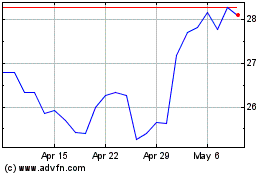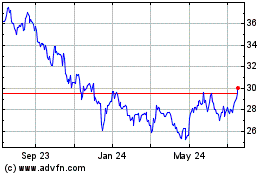By Peter Loftus
Johnson & Johnson's Covid-19 vaccine was authorized for use
in the U.S. by federal health regulators in late February and
supplies of doses are ramping up. It is the third shot to be
cleared after vaccines from Pfizer Inc. and its partner BioNTech SE
and from Moderna Inc. And it is the first shot requiring just one
dose, rather than two. Here's what we know and don't know:
How do the three Covid-19 vaccines compare?
They all work well, health experts say. The Pfizer-BioNTech and
Moderna shots were more than 94% effective at preventing Covid-19
in their late-stage trials, while J&J's effectiveness was 66%.
But the difference may be less than it seems. The Pfizer-BioNTech
and Moderna shots were tested before the emergence of strains like
one first identified in South Africa, which various studies have
indicated eludes vaccines somewhat, though they still work against
it. J&J's vaccine was tested in South Africa, and its
effectiveness wasn't as high there as in other countries, hurting
the vaccine's overall effectiveness. The J&J vaccine was 72%
effective in the U.S. portion of its study.
Yet health experts say J&J's vaccine is plenty effective.
Importantly, it was 85% effective against severe Covid-19 at least
28 days after vaccination. That suggests the vaccine should help
many people avoid the kinds of serious cases that result in
hospitalization and death.
Which Covid-19 vaccine should I get?
Health authorities have generally said people should take the
first vaccine they can get because early supplies have been
constrained. But if you do have a choice, there are some key
differences that could guide your decision. J&J's vaccine is
given as a single dose, which may be a more convenient option than
the two doses required for both of the Pfizer-BioNTech and Moderna
vaccines, given three or four weeks apart. Only the Pfizer-BioNTech
vaccine is authorized for adolescents 16 and 17 years old, while
J&J and Moderna's shots are cleared for those 18 and older.
The U.S. Food and Drug Administration says people who are
allergic to the ingredients of a vaccine shouldn't take it. The
vaccines from Pfizer and Moderna contain, among other ingredients,
the genetic material RNA and a substance called polyethylene
glycol, which has been associated with rare allergic reactions. The
J&J vaccine contains an adenovirus, a virus that can cause the
common cold, which is rendered harmless; polysorbate and other
ingredients.
A healthy, younger woman with a history of an allergic reaction
known as anaphylaxis may opt for J&J's vaccine because there
appears to be a lower rate of such side effects than seen for the
vaccines from Pfizer and Moderna, said Dr. Gregory Poland, a Mayo
Clinic vaccine researcher and fellow with the Infectious Diseases
Society of America. Conversely, a 65-year-old man with a blood type
associated with higher risk of severe Covid-19 may opt for a Pfizer
or Moderna vaccine because of the strong evidence of efficacy in
both clinical trials and real-world use, he said.
When can I get J&J's shot?
A limited supply of doses has been available since the shot was
authorized in late February. J&J said it delivered 20 million
doses for U.S. use by the end of March, and it expects an
additional 24 million in April. By the end of May, J&J expects
it will have delivered a total of 100 million doses for use in the
U.S.
How effective is J&J's Covid-19 vaccine?
It appears to work well. The vaccine's 66% effectiveness rate
shows it can protect a majority of most vaccinated adults from
moderate to severe Covid-19, the disease caused by the coronavirus.
And the vaccine was even more effective preventing severe disease
specifically, posting the 85% rate. By comparison, an annual flu
shot is considered to work well if it is 60% effective.
What are the side effects of J&J's vaccine?
The most common side effects among people who received the
vaccine were injection-site pain, headache and fatigue. Most were
mild to moderate. J&J has received preliminary reports of two
cases of severe allergic reactions in vaccine recipients, one of
which was anaphylaxis.
How was J&J's Covid-19 vaccine tested?
Starting in September, J&J enrolled more than 44,000 adults
in the U.S. and several other countries including Brazil and South
Africa in a clinical trial. The subjects received a single dose of
either the vaccine or a placebo. Researchers counted how many
people subsequently contracted moderate to severe Covid-19 starting
14 days after vaccination, until a certain number of people fell
ill. Researchers then examined whether there were fewer vaccinated
people than unvaccinated people among the Covid-19 cases.
Researchers also monitored for side effects among the study
subjects.
How does J&J's vaccine work?
The vaccine uses a harmless type of virus, called an adenovirus,
which can cause cold symptoms. It is modified to contain the DNA of
the so-called spike protein found on the surface of the new
coronavirus. After injection, the cold-virus vector carries the DNA
payload into human cells. Once inside the cells, the DNA payload
causes the production of the spike protein. This, in turn, triggers
an immune response that can later defend against the real
coronavirus if a vaccinated person is exposed to it.
What don't we know about J&J's Covid-19 vaccine?
We don't know its safety and effectiveness in children, or among
pregnant women, their fetuses or women nursing babies. We also
don't know how long vaccine-induced protection will last. The
company has started a study testing the vaccine in adolescents and
is conducting a separate study testing whether adding a second dose
improves its performance. Also uncertain is whether the vaccine can
help curb the spread of the virus by infected people who don't have
symptoms, a group that turns out to be responsible for a lot of
transmission. A preliminary analysis by J&J gave tantalizing
signs the company's vaccine could limit asymptomatic spread, by
reducing infections that didn't cause symptoms in study
subjects.
Does J&J's vaccine protect against new coronavirus
strains?
The vaccine was less effective in South Africa and Latin America
than in the U.S. That could be a sign the vaccine is less
protective against strains circulating in those regions, though
J&J is still conducting that analysis. J&J's vaccine was
57% effective in South Africa and 66% in Latin America, compared
with 72% in the U.S. during the late-stage trial, according to
J&J. Even at the lower levels of effectiveness in South Africa
and Latin America, health experts say, J&J's vaccine works
well. The company said it is working on a version of the vaccine
targeting the variant first identified in South Africa. Even in
study subjects there, the shot still performed above what health
experts say is needed to protect many people and provide the
community immunity needed to move to a post-pandemic life.
Have there been production problems with the J&J
vaccine?
In late March, J&J said a batch of the main ingredient for
its vaccine that was manufactured at a contractor's plant in
Baltimore didn't meet quality standards. But no finished doses from
the batch were distributed, and the contractor, Emergent
BioSolutions Inc., plans to dispose of the batch. J&J says it
still expects to meet its supply commitments for the vaccine.
Write to Peter Loftus at peter.loftus@wsj.com
(END) Dow Jones Newswires
April 06, 2021 05:44 ET (09:44 GMT)
Copyright (c) 2021 Dow Jones & Company, Inc.
Pfizer (NYSE:PFE)
Historical Stock Chart
From Mar 2024 to Apr 2024

Pfizer (NYSE:PFE)
Historical Stock Chart
From Apr 2023 to Apr 2024
